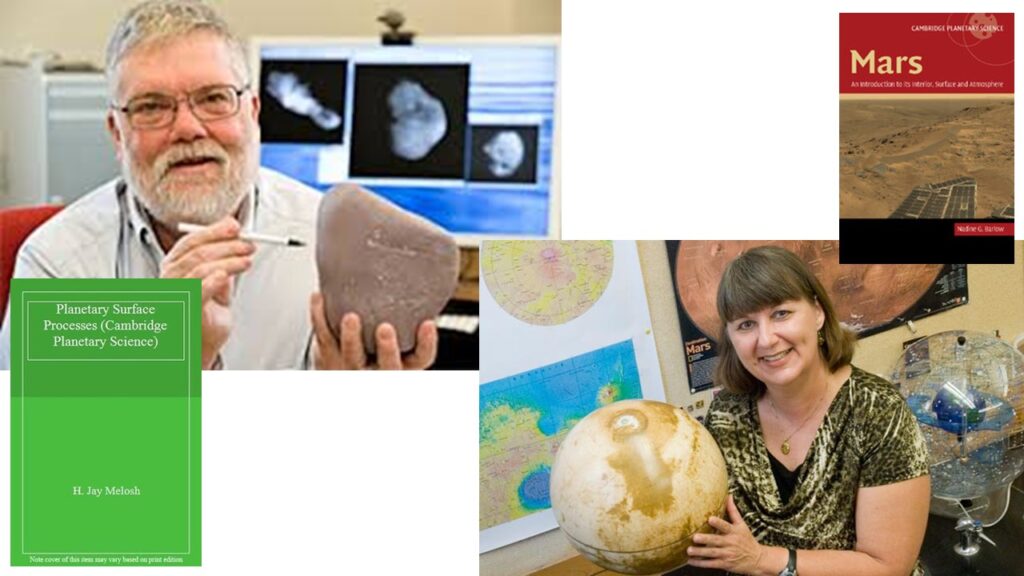EPSC – 30 Setembro
A sessão de ontem no EPSC sobre impactos começou com um duplo choque, difícil de encaixar. A comunidade da ciência planetária perdeu num curto espaço de tempo dois vultos de grande envergadura. H. Jay Melosh faleceu em Agosto; em Setembro desapareceu Nadine Barlow.

Melosh foi talvez o mais destacado estudioso dos aspectos teóricos dos impactos: como se passam as coisas segundo a segundo, como reage o material que sofre o impacto, o que acontece ao objecto que choca com o terreno. Escreveu um livro que é uma verdadeira ‘bíblia’ do tema, chamado Impact Cratering: A Geologic Process (surpresa…). Participou no desenvolvimento de um simulador de impactos disponivel na internet. Há um asteróide baptizado em sua honra: o 8216 Melosh.
Nadine Barlow era uma das maiores especialistas na morfologia das crateras marcianas, assunto sobre o qual publicou diversos artigos fundamentais. Era professora na Northern Arizona University, em Flagstaff, perto do Astrogeology Branch do USGS, com o qual organizava os encontros do Planetary Crater Consortium. Foi numa dessas reuniões que a conheci e a segui numa visita à Meteor Crater, não muito longe de Flagstaff. Também ela está imortalizada num asteróide: o 15466 Barlow.
Quanto à sessão propriamente dita, alguns estudos interessantes: a criação da dicotomia marciana numa colisão sem implicar a fusão do manto; a influência da atmosfera marciana nos ângulos de impacto na superfície; a possibilidade de transporte até à superfície terrestres de materiais ejectados por impactos na Lua. Mais relevantes (na enviesada visão deste observador): um estudo sobre as crateras secundárias na Isidis Planitia; outro sobre a obliteração de crateras marcianas por processos de deposição; e ainda a velha questão da detecção automática de crateras e sua fiabilidade. Outros tópicos abordados foram os impactos em regiões marinhas (da Terra) e as consequências dos impactos para a história da vida na Terra.
Outras sessões tiveram por objecto Métodos de Análise de Dados, Instrumentos para missões futuras, Atmosferas e Interiores de Júpiter e Saturno. E houve a Assembleia Geral da Europlanet, com um apelo à adesão. Como de costume, tudo pode ser (re)visto aqui.
Yesterday’s session about impact processes at the EPSC began with a double shock, hard to stomach. The planetary science community recently lost in quick succession two big figures. H. Jay Melosh died in August, Nadine Barlow passed away in September.

Melosh was perhaps the most important scholar in the theoretical aspects of impact cratering: how things unfold by the second, how does the target material respond, what happens to the impactor when it crashes to the ground. He was the author of the true ‘bible’ of the field, (surprisingly…) titled Impact Cratering: A Geologic Process. He helped in the development of an impact simulator available in the internet. There is an asteroid named after him: 8216 Melosh.
Nadine Barlow was one of the world’s foremost experts on the morphology of martian craters, a subject on which she authored several fundamental papers. She was a teacher at the Northern Arizona University in Flagstaff, close to the Astrogeology Branch of the USGS, with whom she organized the meetings of the Planetary Crater Consortium. It was at one of those that I met her and followed her on a tour of the Meteor Crater, not far from Flagstaff. She is also immortalised on an asteroid: 15466 Barlow.
Speaking of the session itself, there were some interesting studies: the creation of the martian dichotomy by a giant impact without melting of the mantle; the influence of the atmosphere in the angle of collision of small bodies on Mars; the possibility of lunar impacts ejecta reaching the Earth. More relevant (to the biased view of this observer): a study of secondary craters on Isidis Planitia; another on the obliteration of martian craters by sedimentary deposition; and the (seemingly) ages-old question of automated crater detection and its reliability. Other topics which were debated were impacts on marine targets (on Earth), and the consequences of impacts on the history of life on Earth.
Other sessions focused on Methods of Data Analysis, Instruments for future space missions, Atmospheres and interiors of Jupiter and Saturn. And there was the General Assembly of Europlanet, with a plea for registration. As usual, it can all be seen here.


Leave a Reply